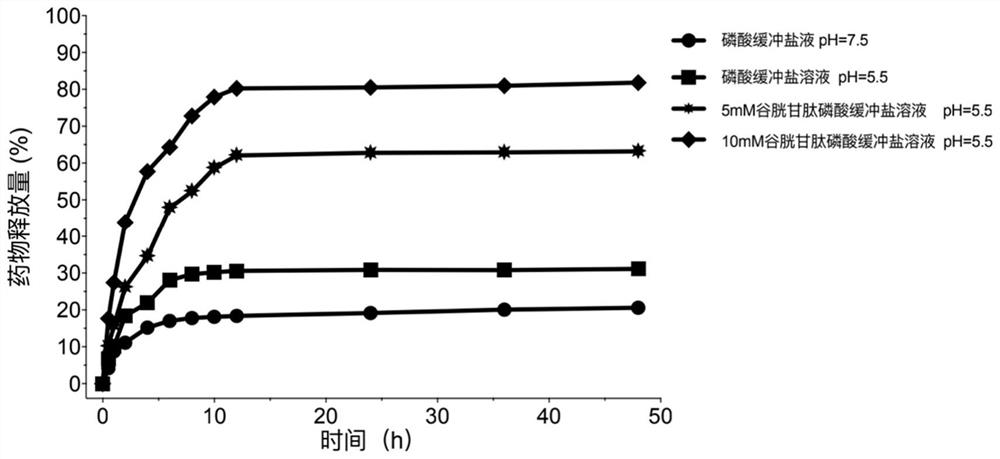Iron-blocking magnetic nano-drug responding to tumor microenvironment, preparation method and application
A tumor microenvironment, magnetic nanotechnology, applied in antitumor drugs, drug combinations, drug delivery, etc., can solve the problems of difficult to achieve clinical integration of diagnosis and treatment, no mediation of tumor treatment, limited targeting efficiency, etc. Achieve the effect of avoiding premature release, improving performance, and increasing load capacity
- Summary
- Abstract
- Description
- Claims
- Application Information
AI Technical Summary
Problems solved by technology
Method used
Image
Examples
Embodiment 1
[0029] Example 1 Preparation of iron-blocking magnetic nanomedicine responsive to tumor microenvironment
[0030] In the first step, cetyltrimethylammonium chloride solution (20g) and triethanolamine solution (3.5g) were mixed and stirred at 80°C for 15 minutes, then tetraethyl orthosilicate (1mL) was added dropwise to react 1 hours, then added a mixture of tetraethyl orthosilicate (0.5mL) and bis[3-(triethoxysilyl)propyl]tetrasulfide (1mL) to continue the reaction for 3 hours, centrifuged and washed 3 times, and washed with The extraction was repeated with 1% NaCl in methanol to remove the templating agent. Then transferred to a 95°C water bath, etched in hot water for 3 hours with the assistance of ammonia water to corrode the inner core of the nanoparticles, washed 3 times and then freeze-dried.
[0031]In the second step, take ferrous acetylacetonate (400mg), thioether hybrid hollow mesoporous silica nanoparticles (25mg), and urea (10mg) and dissolve them completely in 30...
Embodiment 2
[0037] Example 2 Preparation of iron-blocking magnetic nanomedicine responsive to tumor microenvironment
[0038] In the first step, cetyltrimethylammonium chloride solution (20g) and triethanolamine solution (3.5g) were mixed and stirred at 80°C for 15 minutes, then tetraethyl orthosilicate (1mL) was added dropwise to react 1 hours, then added a mixture of tetraethyl orthosilicate (0.5mL) and bis[3-(triethoxysilyl)propyl]tetrasulfide (1mL) to continue the reaction for 3 hours, centrifuged and washed 3 times, and washed with The extraction was repeated with 1% NaCl in methanol to remove the templating agent. Then transferred to a 95°C water bath, etched in hot water for 3 hours with the assistance of ammonia water to corrode the inner core of the nanoparticles, washed 3 times and then freeze-dried.
[0039] In the second step, ferrous acetylacetonate (200 mg), thioether hybrid hollow mesoporous silica nanoparticles (25 mg), and urea (10 mg) are completely dissolved in 30 ml o...
Embodiment 3
[0045] Example 3 Preparation of iron-blocking magnetic nanomedicine responsive to tumor microenvironment
[0046] In the first step, cetyltrimethylammonium chloride solution (20g) and triethanolamine solution (3.5g) were mixed and stirred at 80°C for 15 minutes, then tetraethyl orthosilicate (1mL) was added dropwise to react 1 hours, then added a mixture of tetraethyl orthosilicate (0.5mL) and bis[3-(triethoxysilyl)propyl]tetrasulfide (1mL) to continue the reaction for 3 hours, centrifuged and washed 3 times, and washed with The extraction was repeated with 1% NaCl in methanol to remove the templating agent. Then transferred to a 95°C water bath, etched in hot water for 3 hours with the assistance of ammonia water to corrode the inner core of the nanoparticles, washed 3 times and then freeze-dried.
[0047] In the second step, ferrous acetylacetonate (40mg), thioether hybrid hollow mesoporous silica nanoparticles (25mg), and urea (10mg) were completely dissolved in 30ml of et...
PUM
| Property | Measurement | Unit |
|---|---|---|
| particle diameter | aaaaa | aaaaa |
| particle diameter | aaaaa | aaaaa |
| particle diameter | aaaaa | aaaaa |
Abstract
Description
Claims
Application Information
 Login to View More
Login to View More - R&D
- Intellectual Property
- Life Sciences
- Materials
- Tech Scout
- Unparalleled Data Quality
- Higher Quality Content
- 60% Fewer Hallucinations
Browse by: Latest US Patents, China's latest patents, Technical Efficacy Thesaurus, Application Domain, Technology Topic, Popular Technical Reports.
© 2025 PatSnap. All rights reserved.Legal|Privacy policy|Modern Slavery Act Transparency Statement|Sitemap|About US| Contact US: help@patsnap.com



